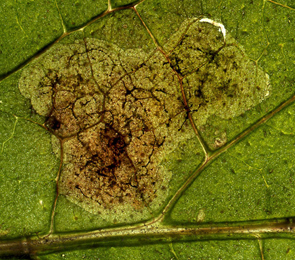|
||||||
|
BRUNNERA. [Boraginaceae] |
|
One species of Brunnera, B. macrophylla (Great Forget-me-not) is recorded in Britain. Two British miners are recorded on Brunnera. A key to the European miners recorded on Brunnera is provided in Bladmineerders van Europa. |
Key for the identification of the known mines of British |
1a > Leaf-miner: A narrow linear leaf-mine, which developes into a large blotch. Several larvae frequently feed together and the resulting mine can entirely fill the leaf (Spencer, 1976: 89). The mine begins with a narrow, parallel sided corridor af 1-8 cm in length, with a nice double frass line. After the first moult the corridor is succeeded, and mostly overrun, by a large, primary, brown blotch. Frass in the initial corridor in short thread fragments, in the blotch in angular granules and thread fragments that often are branching (the frass is unusally sticky). Primary and secondary feeding lines conspicuous. The final mine often is very large and generally contains several larvae, because normally several mines develop on a leaf, and coalesce into one big blotch. Before pupation the larvae leave the mine through a semicircular exit slit that mostly, but not invariably, is in the upper epidermis. The initial narrow gallery contains frass in a double line. It then expands to form a blotch mine. Several larvae may occupy a leaf to form a large blotch. |
|
Agromyza abiens Zetterstedt, 1848 [Diptera: Agromyzidae]. |
1b > Leaf-miner: Mine initially linear, later developing into a whitish blotch, becoming blackish. Pupation in mine on lower surface. The mine begins as an upper surface blotch in the centre of the leaf, from where corridors radiate, each with one larva. After a while these rays fuse, resulting in one large, brown, blotch. Frass in irregular strings. Pupation in principle outside the mine, exit slit in lower epidermis (always?). Often the puparium protrudes from the opening. |
 Mine of Phytomyza medicaginis on Symphytum officinale Image: © Willem Ellis (Bladmineerders van Europa) |
|
Phytomyza medicaginis Hering, 1925 [Diptera: Agromyzidae]. |
| Last updated 01-Jul-2019 Brian Pitkin | ||
